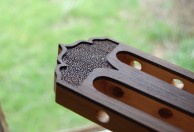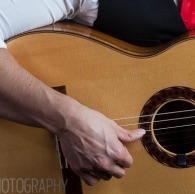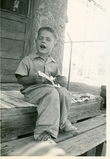Welcome to one of the most active flamenco sites on the Internet. Guests can read most posts but if you want to participate click here to register.
This site is dedicated to the memory of Paco de Lucía, Ron Mitchell, Guy Williams, Linda Elvira, Philip John Lee, Craig Eros, Ben Woods, David Serva and Tom Blackshear who went ahead of us.
We receive 12,200 visitors a month from 200 countries and 1.7 million page impressions a year. To advertise on this site please contact us.
|

|
|
Help..freaking out
|
You are logged in as Guest
|
|
Users viewing this topic: none
|
|
Login  | |
|

  
Anders Eliasson
Posts: 5780
Joined: Oct. 18 2006

|
 RE: Help..freaking out (in reply to Andy Culpepper) RE: Help..freaking out (in reply to Andy Culpepper)
|
|
|
Andy
First of all, new guitars have crisis. Lots of the good one have really bad days the first week or so. They are just grumpy old farts. And you havent even finished your guitar yet, so be patient.
the guitar will change a lot with bindings on the top. The idea of final thicknessing the top before bindings is IMO far out. Completely far out. You will be removing material from the top when you scrape or sand the bindings. My way is to final thickness the top after the bindings and before the bridge. Besides, I dont make a huge difference between the center and the sides of the top. Some 0,2mm.
The back, I dont tune. I make it thin (2mm for negras and a tad more for blancas. If tuned to well, it might interfere with the top.
Finally, all this cladny, taptuning etc is very american (doesnt mean bad. we all all have our ways (read Smirnoffs books and get confused)) Here its done in another way. Mostly just flexing and controling thickness. I tap, but just to record. I would never change the thickness of a well funcioning and well balanced top with a reasonable taptone ( f# - G). Thats what I learned here by Spanish and foreign builders building the spanish way.
So, glue some bindings on her, try not to take to much of the top, finish her and have faith.
Anders
_____________________________
Blog: http://news-from-the-workshop.blogspot.com/
|
|
|
|
REPORT THIS POST AS INAPPROPRIATE |
Date Feb. 21 2010 23:39:15
 |
|

   
estebanana
Posts: 9351
Joined: Oct. 16 2009

|
 RE: Help..freaking out (in reply to Andy Culpepper) RE: Help..freaking out (in reply to Andy Culpepper)
|
|
|
Here is the post I made a few weeks ago- At the time I did not want to countermand your teacher by getting too detailed, but Anders and Stephen Hill have said exactly what I was going to say, but they are nine hours ahead so you get Spain first.
Not everyone in California or the US is crazy about "scientific methods", I look for F to F# or G for the top and separate the back by a half step or more higher than the top. ( I think most of us who build flamencos do that too)
After you build a couple in the Spanish way you begin to get a feel for how thick to make the top before you bind it and learn to get through that period of apprehension while the guitar goes slack when the binding channels are cut.
There's a minefield of wacky mistakes and surprises you can make. My analogy to Stephen Hill's bridge caul incident: I had a maple guitar face down on the solera waiting for the back to go on. I fit the back and glued it on on only to return the next morning to see I had used the wing nut of the bolt and wood bar that holds the guitar to the solera on the inside of the guitar instead of under the solera. I literally bolted my guitar and solera together. My shop mate at the time,Stewart Port, came over to my side of the shop with his camera and said OK Smile and hold it up ! Sarcastically adding "Take your Medicine."
Everyone has done stuff like that, you can't help it there are lots of things to learn. I was able to loosen the bolt, but I had to drill a big hole in the solera and pull the bolt out, then I had to reach in the guitar and saw the bar shorter to remove it. No harm done, but I always check which way the wing nut goes, UNDER the solera!
About the back, you don't want it to be tuned the same as the top because then they would ring in phase with one another, but never quite perfect. I think this is what sets up wolf tones and other strange effects. I'm not scientific about this, but I think that's why you want clear separation in main tap pitch between top and back.
RE: More #1 pics (in reply to deteresa1)
--------------------------------------------------------------------------------
Deteresa quote:
Too late guys the fingerboard is on
I'm going to be doing quite a bit of thinning the edges of the top in the lower bout after the thing is strung up in the white so my teacher suggested to do the bindings later even though it will be more difficult...
EDIT Then I wrote:
well........for next time, when builders speak of tweaking the sound ( or voicing as it's formally called) in the white they usually mean getting it in the general zone and putting the binding on. Then you carve the neck glue on the bridge and finish all the wood working. Then you string it up and sand and scrape the top to voice it.
You'll be fine, but there's something that happens to the top after you put the binding on. When you cut the binding channels around the top it lowers the thump tones of the top. It makes the top go slack. When the bindings get glued on it raises the pitch of the top tap tones again, but maybe not to same pitch they were before the binding channels were cut.
I'm just saying you might want to think about that. When you get experience you can make the judgement call on how thick the top is before binding and you don't have to go through the two things you have to go through next. One taking the fingerboard back off to bind - Two not knowing if the the top will thump the same way after you voice it and then cut the binding channel.
Just saying.
< Message edited by estebanana -- Feb. 5 '10 0:21:51 >
_____________________________
https://www.stephenfaulkguitars.com
|
|
|
|
REPORT THIS POST AS INAPPROPRIATE |
Date Feb. 22 2010 5:04:57
 |
|

   
aarongreen
Posts: 367
Joined: Jan. 16 2004

|
 RE: Help..freaking out (in reply to Andy Culpepper) RE: Help..freaking out (in reply to Andy Culpepper)
|
|
|
If you haven't glued the bindings on the top then it makes perfect sense to me that the guitar would sound like hell.
The concept of when to "tune" the guitar, ie a right time and wrong time is something I can't wrap my head around. Obviously you will alter things when you clean up the bindings by removing wood from the top but I am always working on "tuning" my guitars from when I pick the materials till the strings go on (and sometimes even after that). I tap, flex, sing into the guitar, stick my ear in the soundhole, check a few modes to see how they are shaped and how fast they form with a certain level of stimuli...... Pray, genuflect, appeal to all Gods that may be paying attention, burn incense, float tea leaves, sacrifice virgins maidens.....well maybe not that but it's only because there are no active volcanoes in my area. And one could argue it would be a waste of a perfectly good virgin.:)
Of course I don't take the top to what I believe to be it's final optimum point before the bindings go on, you of course can, but then you better be able to level bindings without touching the top. Not easily done if you want a flawless surface.
I also don't agree with the "Spanish" way or the "American" way. There's "my" way and that's it. I don't mean me as opposed to you, I mean all of us. In the end this is something we all figure out for ourselves, it can't be any other way.
Glue on your bindings and pay attention to each step in your process, build lots of guitars and you will start finding some answers. Which of course leads to more quesitons but thats what keeps it interesting.
|
|
|
|
REPORT THIS POST AS INAPPROPRIATE |
Date Feb. 23 2010 4:48:21
 |
|

   
aarongreen
Posts: 367
Joined: Jan. 16 2004

|
 RE: Help..freaking out (in reply to Anders Eliasson) RE: Help..freaking out (in reply to Anders Eliasson)
|
|
|
quote:
I know what you mean Aaron, And it might be to square to talk about American or Spanish ways. It was just an ilustration. And there is something in it. Its not a coincidence tha Smirnoff (the one with the taptuning books) is American. The percentage of builders building like that or using some methods like that is A LOT higher in the US than in Spain.
I think what you are seeing is the one of the effects that the information sharing system started by the Guild of American Luthiers has had on lutherie in general. So yes this from that point of view, one could state that this book is the product of what was started in America. Which is far from a bad thing (not that you implied that it was bad). Many builders have gone through great trouble to share their experience, and by doing so have contributed to the greater understanding and as a result everyone's work has gotten a lot better, rising tides raise all ships as it were. In the 20 years or so I have been building I have seen standards go up considerably. Many of those builders have done rather well for themselves, doing well by doing good, so it makes sense that others will try to promote their own agenda or reputation via this route. There is a well known book from England, called Making Master Guitars that I would put into this category. Not that all the info is bad but the section on making has a lot of issues that shows quite clearly to me the level of work the author was, at time of writing, capable of and it falls short of the title. So you know, it's not just the Americans.:)
Getting back to Smirnoff's book, I will state for the record that I have never seen it but find the concept pretty far out there. In that kind of abstract format a book on plate tuning makes a lot more sense as it is a visual and much more apparently analytical methodology. Now as someone who studied with one of the most published proponents and researchers into the science of acoustics, I can state with a fair amount of credibility that in no way, shape or form is this anything other than another way of looking at what already exists and we all deal with everyday in our shops.
The idea that science or an analytical approach is there to refute is incorrect. It's like a candle in the dark, what's there is there regardless of whether it's illuminated or not. If it's a good guitar, and good musicians like it, then this methodology may help show you why that is, in this particular case. If it's a bad guitar and no one likes it, then it might help you understand, in another way, why that is, in this particular case. That's it.
In my own work I am always tapping and flexing my guitars, and when there is something I don't think is quite right, I find it extremely helpful to run the first main wood modes, the top in particular and how it is shaped and how quickly is information that I can use. In the end if I like the way the guitar sounds when tapped, feels when flexed then I can guarantee you that the modes will be well formed.
Anything can be turned into religion and in our modern world, science is perceived to trump all (although I find it incredibly interesting that quantum mechanics is basically saying what Buddhists have been saying for thousands of years) this is a fault of the practitioners, salesmen or those who want a shortcut at any expense. Smirnoff's methods may work for him although the only way to prove that is of course to play one of his guitar, which I haven't.
Frankly however you go about building guitars, the final proof is in the pudding as it were. There are a ton of mediocre builders the world over and there are great masters in every country. If you are getting great results, consistently, and great guitarists want top play your guitars....then you know what you are doing and no amount of science or voodoo can refute that. In the case of science though it will, if it's real, support that fact. So I advise everyone to learn a bit about the mechanics of what makes a guitar tick, if for no other reason than to have another way of interpreting what is going on when they are in their shop.
aaron
|
|
|
|
REPORT THIS POST AS INAPPROPRIATE |
Date Feb. 24 2010 5:31:21
 |
|

   
estebanana
Posts: 9351
Joined: Oct. 16 2009

|
 RE: Help..freaking out (in reply to Andy Culpepper) RE: Help..freaking out (in reply to Andy Culpepper)
|
|
|
Those books are a on a shelf at my friend and Stewart's shop where I used to have a bench. I looked at them one day, scratched my head, then put them back on the shelf. Then asked Stew if he wanted to go the taco truck for lunch.
As far the binding ledge around the top, I had one more thing to add. I try to get the top into the zone" as I call it where I think it will be good enough to cut the binding channels.
I have noticed that if you have a tap tone on the top and you cut the channels obviously we all are a talking about it falling and sounding horrible.
But how much will it tighten up when you bind the box? Will the tap tone rise to the same pitch when you bind it? I don't think there is a solid answer to that because it all depends on a few factors regarding how much top is cut away.
I can't tell ahead of time if the top will return to exactly the same tap tone because I often change the width of the bindings and whether the channel is cut in one swath for purfling and binding or a separate ledge of purfling with binding wrapped around it. The other puzzle piece is how wide is the liner or glue block rim and how much of the top is left glued to the rim?
These questions have fascinated me not only for how much the tap tone rises and falls during the binding process, but for the generation of sound out of the drum head of the top and whether or not laminated liners or glue blocks make difference in volume.
I've made two observations, first that cutting the binding channel as one swath and using purfling that backs the binding for it's full height makes for one tight drum head. Especially if you use hot hide glue and rope the binding to the top in the traditional manner. The binding is not the same as top wood, but I always wonder how much that tight band of laminated wood, binding and purfling, bolsters up the top. It's almost like a brace. To make an esoteric comparison, I think it's like the famous dome in Italy that has a giant chain wrapped around its base to keep it from spreading. ( is that Saint Peter's? )
Second observation, I used to think that laminated liners made for louder guitars, now I'm not so sure because my last guitar has glue blocks and it's super loud. I still like using liners, but have newfound respect for glue blocks. Notwithstanding other factors like maybe I just used a smaller plantilla and wider glue blocks which set up a smaller surface area to energize.
So those questions are interesting to me, but it's very difficult and maybe not possible to scientifically examine them. I do know I get a big thrill when I bind a top and the tap tone goes back up. Whew!
I think I need a vodka cranberry.....made with Hangar One vodka , from Alameda, CA.
_____________________________
https://www.stephenfaulkguitars.com
|
|
|
|
REPORT THIS POST AS INAPPROPRIATE |
Date Feb. 24 2010 12:05:09
 |
|

   
HemeolaMan
Posts: 1514
Joined: Jul. 13 2007
From: Chicago

|
 RE: Help..freaking out (in reply to estebanana) RE: Help..freaking out (in reply to estebanana)
|
|
|
firstly:
Taco Truck? I want one!
Secondly: As it turns out, according to Bruné, the guitars that have the plans in the courtnall books are wrong. In fact he modified the originals to more closely match his guitars. and the measurements are wrong too i guess. says he
I'd like to say that Bogdanovich's book is possibly my least favorite waste of money yet. "we are going to use as few powertools and jigs as possible" "now lets waltz over to the tablesaw, router table, plunge and trim routers, bandsaw, jointer, planer, fox bender. Also, you'll need to make this needlessly elaborate jig for your router base, and then dont forget to use laminate back and sides, and oh lets make a mold!"
what a fop.
Pardon my ignorance, but why would the tap tone be a good thing to have higher than 90Hz or so? a low E is 85 Hz... seems sensible that the instrument should be resonant at the fundamental pitch of two of its strings (the higher being naturally in the overtone series)?
_____________________________
[signature][/signature]
|
|
|
|
REPORT THIS POST AS INAPPROPRIATE |
Date Feb. 24 2010 21:19:14
 |
|
 New Messages New Messages |
 No New Messages No New Messages |
 Hot Topic w/ New Messages Hot Topic w/ New Messages |
 Hot Topic w/o New Messages Hot Topic w/o New Messages |
 Locked w/ New Messages Locked w/ New Messages |
 Locked w/o New Messages Locked w/o New Messages |
|
 Post New Thread
Post New Thread
 Reply to Message
Reply to Message
 Post New Poll
Post New Poll
 Submit Vote
Submit Vote
 Delete My Own Post
Delete My Own Post
 Delete My Own Thread
Delete My Own Thread
 Rate Posts
Rate Posts
|
|
|
Forum Software powered by ASP Playground Advanced Edition 2.0.5
Copyright © 2000 - 2003 ASPPlayground.NET |
0.109375 secs.
|


 Printable Version
Printable Version















 New Messages
New Messages No New Messages
No New Messages Hot Topic w/ New Messages
Hot Topic w/ New Messages Hot Topic w/o New Messages
Hot Topic w/o New Messages Locked w/ New Messages
Locked w/ New Messages Locked w/o New Messages
Locked w/o New Messages Post New Thread
Post New Thread